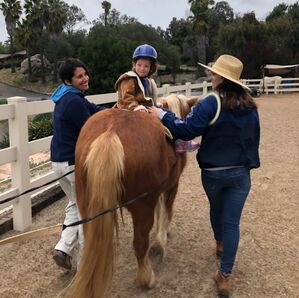|
You may be wondering, “What exactly is hippotherapy?” Misleading in name, hippotherapy has nothing to do with hippopotamuses (“hippo” is the Greek word for horse). Here at OT OuTdoors occupational therapists utilize the movement of the horse as a treatment tool with our clients to promote strength, posture, coordination, sustained attention and sensory processing. Why a horse? Equine movement is “multidimensional, provides a client’s body with motor and sensory input, can be manipulated, and is rhythmic, low amplitude, consistent and sustainable” (American Hippotherapy Association). Paired with other occupational therapy interventions, it helps a client develop functional skills, like riding a tricycle or bicycle.
Participating in a family bike ride is a goal for one of our clients here at OT OuTdoors. She is working on improving her balance, strength, and learning to use the muscles required to pedal her tricycle. How does hippotherapy come into play? The horse automatically stimulates some of the muscle patterns that are required for bike riding, like reciprocal patterning. The horse’s movement internally establishes the rhythm and timing she needs to pedal. Having the client sit on the horse in different positions is also a technique the therapist can use. Each position offers different balance and strengthening opportunities. The therapist can also utilize and manipulate tack (riding equipment) to specifically strengthen and prepare certain muscle groups. For our tricycle riding friend, using the positions of forward and side sitting allow us, as therapists, to assist her in achieving her goal. While riding forward the use of stirrups provide strengthening and feedback to and from her feet, legs and abdominals. With each foot fall of the horse, pressure is inputted into the stirrups, therefore her entire leg. First activating these muscles on horseback sets her up perfectly for engaging those same muscles when needing to push the pedals of her trike! Having her ride side sitting on the horse employs similar concepts. This position requires the client to engage her lower abdominals to help maintain balance. This in turn strengthens and prepares her lower abdominals to initiate pushing on the bike pedals and fires up her righting reactions to maintain balance. The magnificent horse, the perfect occupational therapy treatment tool for learning to ride a bike! OT OuTdoors "... because life doesn’t happen in a clinic" Sara Martinez OTAS Level II Fieldwork Student and Carrie R. Jacobs M,OTR/L
1 Comment
 Here at OT OuTdoors we have over 20 years of experience in sensory integration and use a multi-sensory approach to promote handwriting skills for our clients. We use a variety of approaches and resources in our interventions that include flashlight games, use of putty, shaving cream and other fun textures and games and themes dependent upon each clients individual interest. We incorporate techniques from Educlime, Handwriting Without Tears, and First Strokes just to name a few. Pictured above is one of our 5yr old friends “fishing” for the letters in his name. This fun activity allows him to practice his fine motor grip, in-hand manipulation and hand-eye coordination skills as well as increase the strength and endurance in his arms and hands. All the while he is practicing his letter recognition. Improving all skills required for handwriting success! This is one of many activities that can be performed at OT OuTdoors and practiced at home. Other fun activities to encourage and promote handwriting at home include:
OT OuTdoors "... because life doesn’t happen in a clinic" Sara Martinez OTAS Level II Fieldwork Student and Carrie R. Jacobs M,OTR/L |
Archives
April 2024
Categories |



 RSS Feed
RSS Feed
